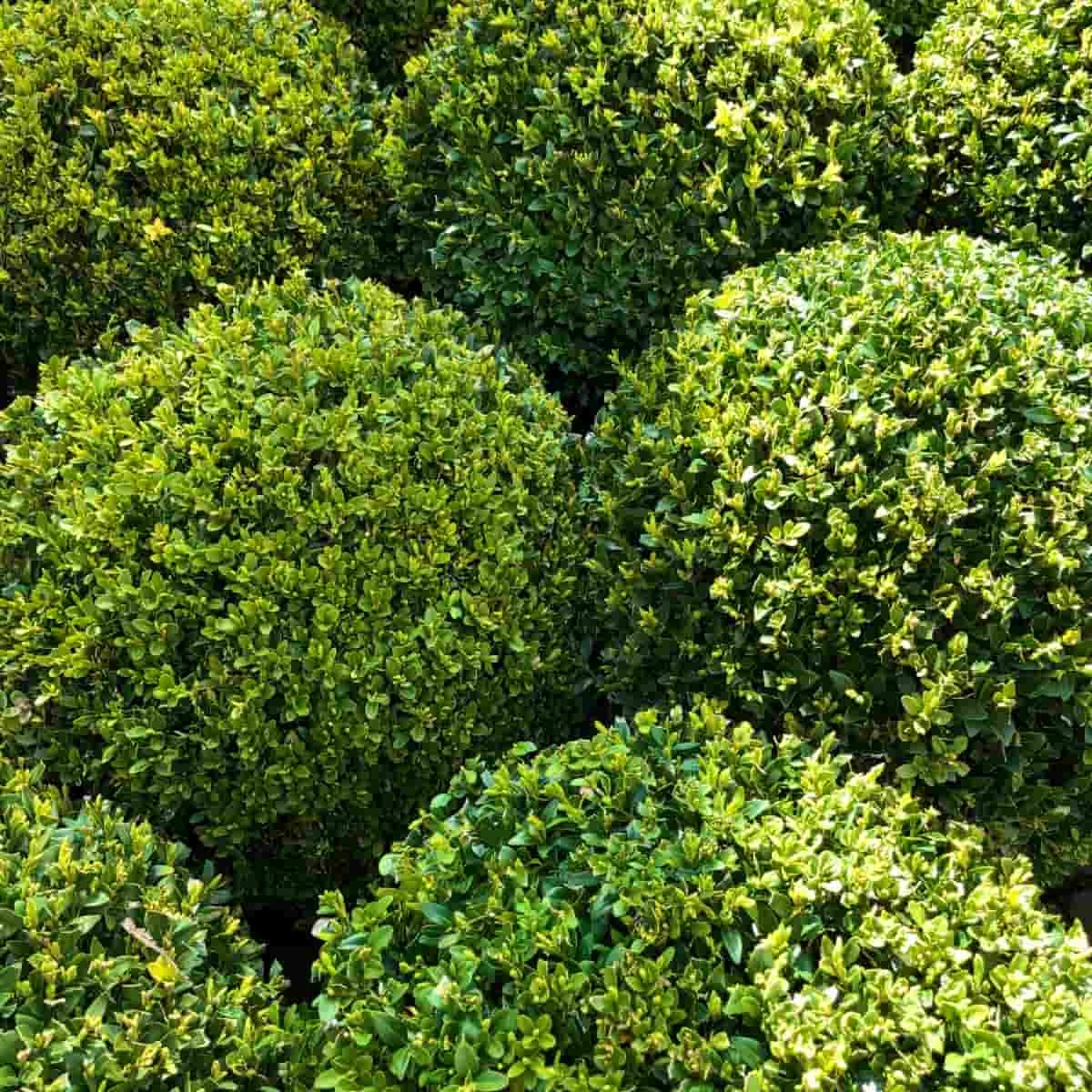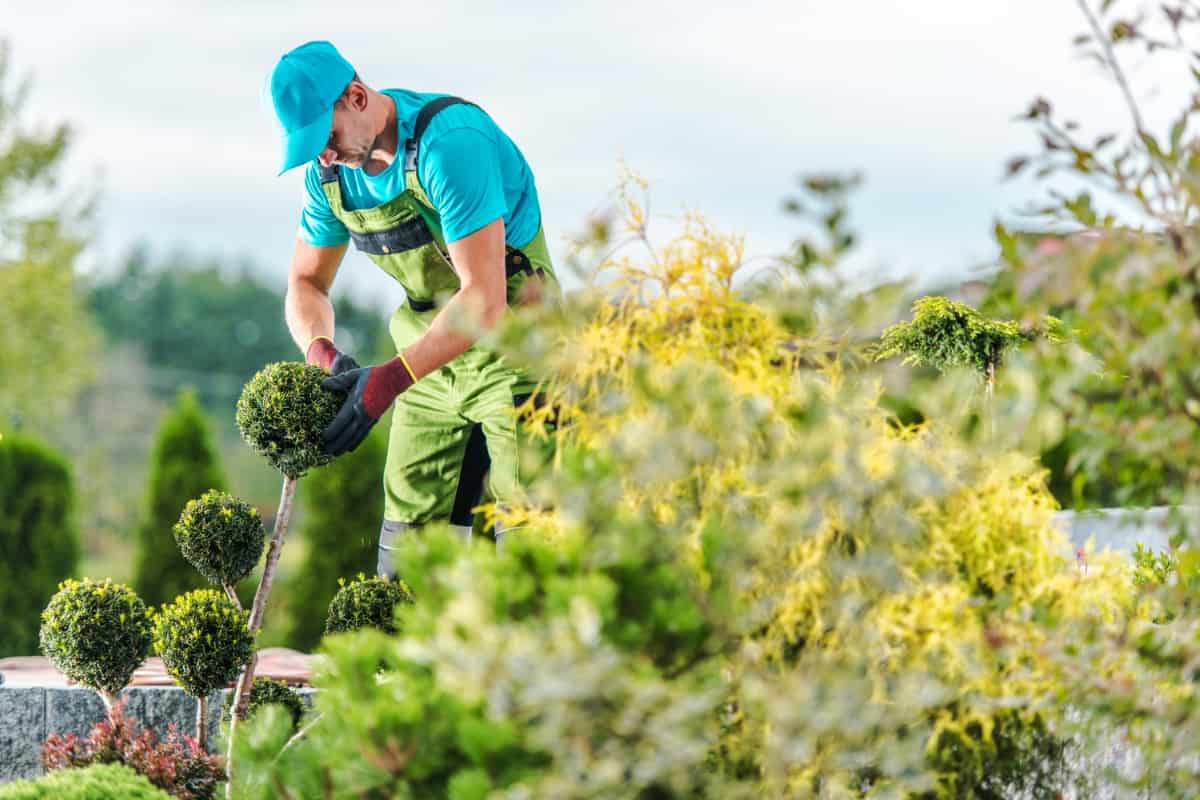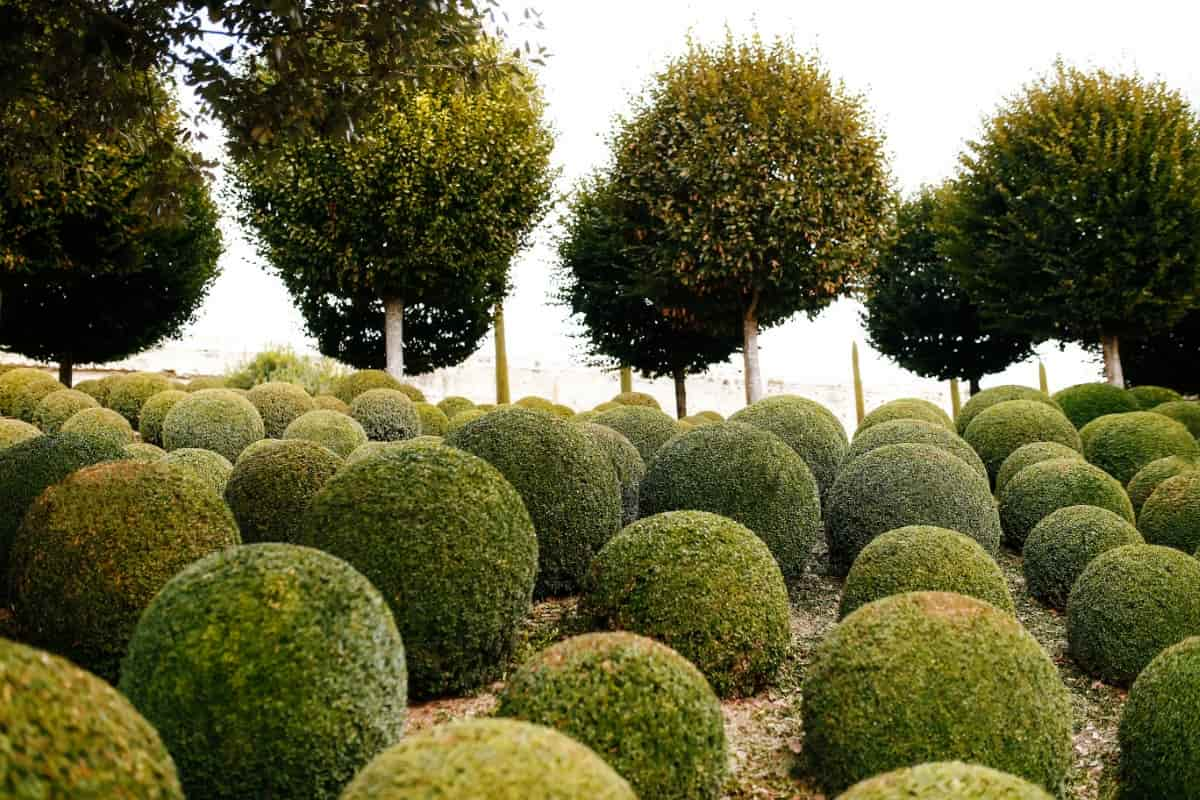What causes box blight? It is caused by the Calonectria pseudonaviculata fungus, which affects box plants. Box blight doesn’t kill the roots but weakens the plants. Recovery is possible, but it takes perseverance to keep the problem under control – this is easier if you catch it early. This article will explore how to identify and treat boxwood blight naturally. By following these strategies, you can effectively control and prevent the spread of this destructive disease.

How to Identify and Treat Boxwood Blight
Boxwood Blight Symptoms
- A yellow halo is often present around tan or brown spots on the leaves as an early sign of boxwood blight.
- As the spots grow, entire leaf sections turn brown until the entire leaf is affected.
- Both sides of the leaf are usually affected by these lesions. Infected leaves develop masses of fuzzy, white spores if conditions are right.
- A leaf spot stage may go unnoticed due to the rapid progression from a leaf spot to defoliation.
- Boxwood blight can be distinguished from other common boxwood problems by the absence of lower leaves.
Natural Treatments for Boxwood Blight
Proper sanitation practices play a crucial role in managing Boxwood Blight. It is important to clean and disinfect any tools or equipment used to care for and maintain boxwood plants. This can help prevent the unintentional transmission of the pathogen from one plant to another. Regularly removing fallen leaves and debris from around boxwood plants can also reduce the presence of the pathogen and minimize the risk of infection.
Compost tea is a natural, nutrient-rich liquid made from composted materials. It contains beneficial microorganisms that help suppress boxwood blight and improve plant health. Incorporating resistant varieties of boxwoods into your landscape can be another natural boxwood blight treatment. Some boxwood cultivars have shown a higher resistance level to the disease and can be less susceptible to infection. When selecting boxwood plants for your landscape, it is advisable to choose cultivars bred for resistance to Boxwood Blight.
Cultural Practices for Boxwood Blight Control
Another natural treatment for Boxwood Blight is the use of cultural practices. These practices involve creating an environment that is less favorable for the growth and spread of the pathogen. It is recommended to space boxwood plants properly to promote required air circulation and reduce the likelihood of disease development. Additionally, removing and disposing of infected plant material can prevent disease transmission to healthy plants.
Biological Controls for Boxwood Blight
Trichoderma spp: Trichoderma species are naturally occurring fungi that have been found to have antagonistic effects against various plant pathogens. Studies have shown that certain strains of Trichoderma can inhibit the growth of Calonectria pseudonaviculata and reduce the severity of boxwood blight. These fungi work by competing with the pathogen for nutrients and space and producing antifungal compounds.
Bacillus subtilis: Bacillus subtilis is a beneficial bacterium widely used in agriculture for its biocontrol properties. It has been shown to have antifungal activity against various plant pathogens, including Calonectria pseudonaviculata. Bacillus subtilis produces enzymes and antimicrobial compounds that can inhibit the growth of the pathogen and protect boxwood plants from infection.
Streptomyces spp: Streptomyces species are filamentous bacteria known for producing various bioactive compounds. Some strains of Streptomyces have been shown to have antifungal activity against Calonectria pseudonaviculata. These bacteria can colonize the rhizosphere of boxwood plants and protect against boxwood blight by producing antifungal metabolites.
Mycoviruses: Mycoviruses infect fungi, including Calonectria pseudonaviculata. Some mycoviruses have been found to reduce the pathogen’s virulence and suppress the symptoms of boxwood blight. These viruses can be used as biological controls by infecting the pathogen and interfering with its ability to cause disease.
Alternative Treatments for Boxwood Blight
- Regularly clean and disinfect tools and equipment used in pruning and trimming boxwood plants. This prevents the spread of the fungus from infected plants to healthy ones.
- Promptly remove and dispose of infected branches to prevent the disease transmission to other parts of the plant.
- If you suspect boxwood blight in your garden or landscape, quarantine the infected plants to prevent the spread of the disease. Avoid moving potentially infected plants to other locations.
In case you missed it: How to Identify and Treat Tomato Blights: Organic Prevention and Natural Control

Preventing Boxwood Blight Naturally
While natural treatments can help manage Boxwood Blight, it is important to note that prevention is key. How to prevent box blight? Proper plant care and maintenance, including regular pruning, watering, and fertilizing, can help maintain the overall health and vigor of boxwood plants, making them less susceptible to disease. Monitoring boxwoods for any signs of disease, such as leaf spots or yellowing, can help detect the presence of Boxwood Blight early on, allowing for prompt treatment and management.
Organic Fungicides for Boxwood Blight
Several organic fungicides are available that can help suppress boxwood blight. These boxwood blight treatment fungicides contain natural compounds such as neem oil, copper, or sulfur, which have antifungal properties. It is important to carefully read and follow the product label instructions when using fungicides.
Integrated Pest Management for Boxwood Blight
Regularly monitor the health of boxwood plants and keep detailed records of pest and disease occurrences. This will help identify patterns and make informed decisions regarding pest management strategies.
- Consider using beneficial insects, such as predatory mites or ladybugs, to control pests that may play a role in spreading the disease from affected branches to healthier ones and weaken boxwood plants and make them more susceptible to disease.
- Encouraging natural enemies can help maintain a balanced ecosystem and reduce the need for chemical pesticides. Install birdhouses and feeders to attract birds that feed on pest insects.
- Use microbial products containing beneficial bacteria or fungi that can suppress disease-causing pathogens.
Consulting with Experts on Boxwood Blight
One of the key experts to consult with is an agricultural extension specialist. These specialists are trained professionals who provide information and guidance to farmers, gardeners, and other individuals in the agricultural community. They can provide valuable insights into boxwood blight, including recommended prevention and management strategies.
Another expert to consult is local horticulturists or arborists with experience working with boxwood plants. These professionals can provide practical advice on how to identify boxwood blight, as well as tips for maintaining healthy boxwood plants. They may also be familiar with local regulations and guidelines for managing boxwood blight in your area.
When consulting with experts, it is important to come prepared with questions and observations about your boxwood plants. Be ready to provide information about the symptoms you have observed, the history of the affected plants, and any recent changes in environmental conditions. This will help the experts better understand your situation and provide tailored recommendations.
In case you missed it: How to Treat Early Blight in Eggplants: Symptoms, Control, and Remedies

Conclusion
By identifying boxwood blight and implementing natural methods for treatment and prevention, you can effectively control and minimize the impact of this destructive disease. Remember to regularly monitor your boxwood shrubs, practice good sanitation, and employ cultural practices to create a healthy plant environment. By taking these proactive measures, you can ensure your boxwood garden’s long-term health and vitality.
- Feed Your Flock for Less: Top 10 Tips to Save on Chicken Feed
- Ultimate Guide to Ossabaw Island Hog: Breeding, Raising, Diet, and Care
- Hatching Answers: The Top 10 Reasons Your Chickens Aren’t Laying Eggs
- Eggs and Economics: Breaking Down the Cost of Raising Backyard Chickens
- Defend Your Greens: Proven Methods to Keep Iguanas Out of Your Garden
- Ultimate Guide to Cinnamon Queen Chicken: A Comprehensive Guide for Beginners
- Ultimate Guide to California Tan Chicken: Breeding, Raising, Diet, Egg-Production and Care
- Ultimate Guide to Marsh Daisy Chicken: Breeding, Raising, Diet, and Care
- 10 Types of Chicken Farming Businesses You Can Start for Profits